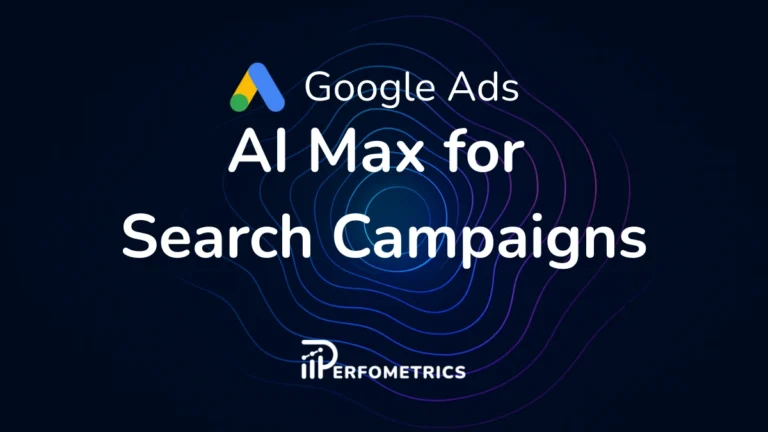Types of Bidding Strategy in Google Ads [Comprehensive Guide]

Google Ads bidding strategies, as we are all well aware, are one of the most critical levers for optimizing marketing campaigns and driving substantial business growth. These different types of bidding strategies go beyond merely deciding how much to pay for a click; they involve strategically instructing Google on how to invest your budget to achieve your most important business outcomes. And as marketers, business owners and growth specialists, the constant pursuit of ways to optimize campaigns for better results leads us to focusing on these strategies.

At the heart of Google Ads is a real-time auction. Every time an ad spot is available on a search results page or across the Google Network, an auction takes place.3 Your ad’s ability to appear and where it appears, is determined by its Ad Rank. This rank isn’t just based on your bid; it’s a complex calculation involving your bid amount, your ad’s Quality Score (which includes expected click-through rate, ad relevance and landing page experience) and the expected impact of ad extensions and other ad formats.1
Understanding this auction is key because Google Ads offers a diverse toolkit of bidding strategies, each tailored for different advertising objectives.
Choosing the right bidding strategy means you’re not just spending money; you’re making a strategic allocation of your marketing resources. It dictates how Google’s powerful algorithms interpret what “value” means for your specific campaign and how they pursue that value in the fiercely competitive ad auction. Additionally, the evolution of these bidding strategies, particularly the rise of automated and Smart Bidding, mirrors a broader transformation in marketing: the increasing role of Artificial Intelligence in handling complex, data-rich tasks. This shift doesn’t make you redundant; instead, it brings your role from manual bid-setter to strategic director, guiding the AI to achieve your core business goals.
The Key Principles:
- Align with Your Goals: Your business objectives must be the North Star guiding your strategy selection.
- Build on Solid Data: Accurate conversion tracking and sufficient historical data are the bedrock of effective automated bidding.
- Choose Your Control Level: Decide whether manual oversight or AI-powered automation best suits your resources and goals at any given time.
- Commit to Optimization: Continuously monitor, test and iterate. The digital marketplace never stands still and neither should your approach to bidding.
Manual vs. Automated Bidding Strategies: Choosing Your Level of Control
When you first encounter the different bidding strategies in Google Ads, you’ll notice a fundamental choice: manual or automated bidding. This decision determines the level of direct control you retain versus the degree to which you leverage Google’s AI.
Manual Bidding: Precision and Direct Oversight
Manual Cost-Per-Click (CPC) bidding is exactly what it sounds like: you, the advertiser, set the maximum amount you’re willing to pay for each click (max. CPC) on your ads. This can be done at the ad group level or for individual keywords, giving you precise control over your bids.4 Your bids remain static until you decide to change them.5
| Pros | Cons |
| Granular Control: You have direct oversight of what you’re willing to pay for every click, which can be comforting, especially with tight budgets.2 Transparency: It’s often the easiest strategy to understand, making it a good starting point for those new to Google Ads.5 Flexibility: Allows for immediate bid adjustments based on your observations of device performance, location targeting, ad scheduling and specific audience segments.7 | Time-Intensive: Requires constant monitoring, analysis and manual adjustments to remain competitive and effective, which can be a full-time job.2 Limited by Human Capacity: You’re making decisions based on the data you can see and process. Google’s AI, used in automated strategies, considers a vast array of real-time signals that are simply beyond human capability to analyze simultaneously.5 This can lead to “underinformed decisions”.5 Slower to React: Manual bids can’t adapt to the rapid |
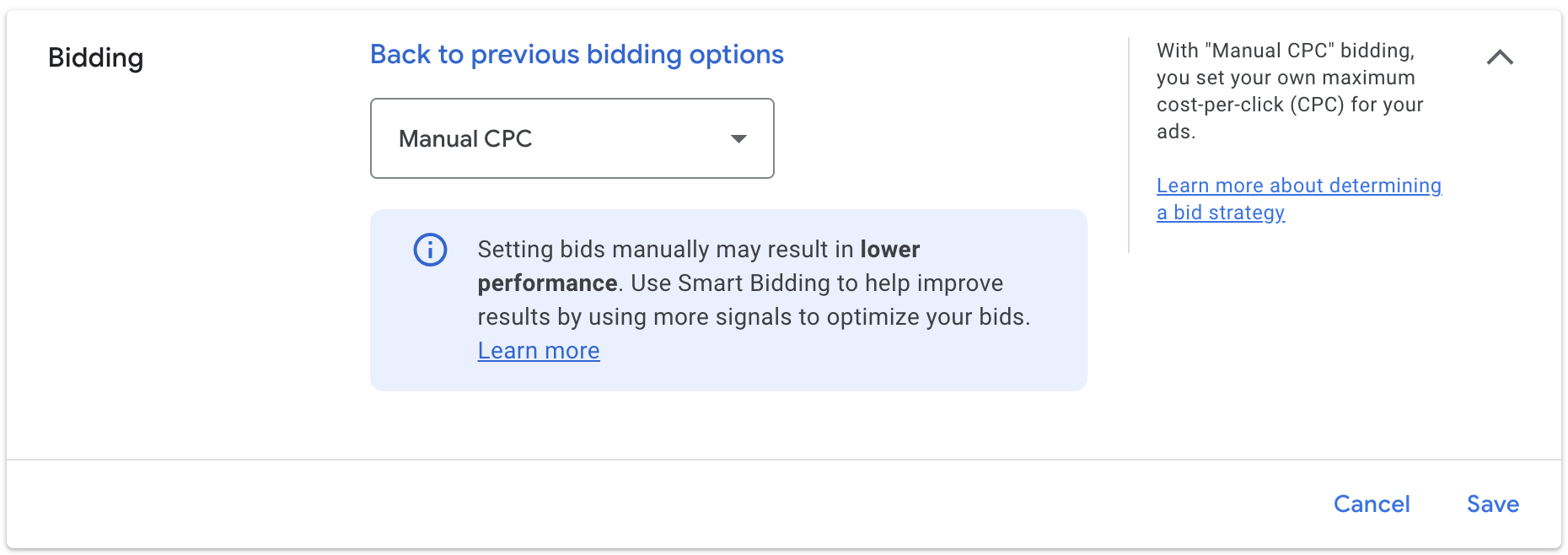
When is Manual CPC a Good Fit?
Despite the rise of automation, Manual CPC still has its place. It’s often recommended for:
- New Accounts: For brand new campaigns, especially those with no historical conversion data, starting with Manual CPC (often with a cautious approach to bids) can be a safe way to gather initial performance data and “figure things out” without risking overspending by an algorithm that’s still learning.3 It allows you to directly test the waters for specific keywords.
- Small or Highly Specific Budgets: If your budget is very limited and you need to scrutinize the cost of every single click, manual bidding offers that direct control.
- Diagnostic Purposes: Experienced advertisers might use Manual CPC to troubleshoot underperforming campaigns or to test hypotheses about specific keyword bids without algorithmic interference. This direct feedback loop provides clearer baseline performance data.
However, while Manual CPC offers the illusion of complete control, this “control paradox” means you’re limited by your own analytical bandwidth and the data visible to you. Automated systems, by contrast, relinquish some direct control but tap into far deeper data pools and real-time signals, potentially leading to superior outcomes if your goals are clearly defined for the AI.8
Automated Bidding: Using Google’s AI for Efficiency
Automated bidding strategies empower your Google Ads campaigns to automatically set and adjust your bids in real-time, leveraging sophisticated machine learning algorithms to help you achieve your specific campaign goals.1 This approach effectively takes the “heavy lifting and guesswork out of setting bids”.8 These strategies are designed to learn as they go, using ongoing performance data to inform and refine future bid decisions.8
A significant advancement within automated bidding is Smart Bidding. This subset of strategies is specifically designed to optimize for conversions or conversion value. Smart Bidding employs “auction-time bidding,” meaning it sets a unique bid for each and every auction your ad is eligible for.2 To do this, it analyzes a massive array of real-time contextual signals. These can include:
- Device type (mobile, desktop, tablet)
- User’s physical location and location of interest
- Time of day and day of the week
- Remarketing lists and audience characteristics
- Language preferences
- Operating system and browser
- The specific search query entered by the user
- And many more nuanced signals.6
Key Benefits of Automated & Smart Bidding:
- Time Savings: Significantly reduces the manual effort required to manage bids, freeing you to focus on broader strategy.8
- AI-Powered Precision: Leverages Google’s advanced machine learning, which trains on vast datasets to make more accurate predictions about bid impact than a human typically could.9
- Real-Time Optimization: Adapts bids dynamically to the unique context of each auction.
- Goal-Oriented Performance: Designed to achieve specific outcomes like maximizing clicks, conversions, or revenue. It’s no surprise that more than 80% of Google advertisers are now using some form of automated bidding.12
While incredibly powerful, the complex algorithms behind Smart Bidding can sometimes feel like a “black box.” This doesn’t mean you lose all control; rather, your role shifts. Instead of micromanaging individual bids, you focus on providing high-quality strategic inputs: ensuring your conversion tracking is flawless, defining clear business goals for the AI to pursue, structuring your campaigns logically and feeding the system relevant audience signals. The AI is a powerful tool, but its effectiveness is directly tied to the quality of the data and the clarity of the direction you provide.11
Automated and Smart Bidding democratize access to sophisticated, AI-driven optimization. Capabilities that once required large analytical teams or expensive third-party software are now available to a much broader range of advertisers, including small and medium-sized businesses. This levels the playing field to some extent but also elevates the importance of strategic thinking to truly harness this power.
Different Google Ads Bidding Strategies Explained
Now that you understand the overarching choice between manual and automated control, let’s explore the different bidding strategies in google ads in detail. Each is designed with specific advertising goals in mind. To help you navigate these options, here’s a quick guide:
Quick Guide to Google Ads Bidding Strategies
| Strategy Name | Primary Goal | How It Works (Brief) | Ideal For | Key Consideration |
| Manual CPC | Full control over individual click costs | You set max. CPC for keywords/ad groups. | New accounts, small budgets, diagnostics, experienced managers wanting precise control. | Time-intensive; can be less responsive than AI. |
| Maximize Clicks | Drive as much website traffic as possible | Google AI sets bids to get the most clicks within your budget. | Brand awareness, initial traffic generation, top-of-funnel campaigns, data gathering for new accounts. | Crucial: Set a Max CPC limit to control costs and avoid overpaying for clicks. |
| Maximize Conversions | Get the most conversions within your budget | Google AI sets bids to maximize conversion volume, aiming to spend the full budget. | Lead/sales volume focus, campaigns with sufficient budget, building conversion data. | Requires accurate conversion tracking; can add optional Target CPA for cost control. |
| Target CPA | Achieve conversions at a specific average cost | Google AI sets bids to get as many conversions as possible at your target CPA. | Lead generation with known lead value, campaigns needing strict cost-per-conversion control. | Requires sufficient conversion history; set realistic CPA targets. |
| Maximize Conversion Value | Maximize total revenue/value from conversions | Google AI sets bids to prioritize conversions that bring the most value. | E-commerce with varied product prices, businesses where different conversions have different values. | Crucial: Must track and assign values to conversions; can add optional Target ROAS. |
| Target ROAS | Achieve a specific return on ad spend | Google AI sets bids to maximize conversion value at your target ROAS. | E-commerce with clear revenue goals, profit-driven campaigns. | Requires robust conversion and value tracking, sufficient data; set realistic ROAS. |
| Target Impression Share | Achieve specific visibility on SERPs | Google AI sets bids to show your ad at a chosen location (top, absolute top) for a % of time. | Brand awareness, brand term protection, competitive niches where visibility is key. | Crucial: Set a Max CPC limit to control costs; focuses on visibility, not conversions. |
| CPM / vCPM / CPV | Awareness / Views / Engagement (Display/Video) | Pay per 1000 impressions (CPM), viewable impressions (vCPM), or video views (CPV). | Brand awareness campaigns on Display Network or YouTube. | Not primarily for direct response/conversions. |
Driving Website Traffic: Click-Focused Strategies
If your immediate goal is to bring more visitors to your website, perhaps to build brand awareness or to feed the top of your marketing funnel, these strategies are designed for you.
Maximize Clicks
- Objective: To get as many clicks as possible within your specified daily budget.1
- Mechanism: This is an automated bid strategy where Google’s AI works to bring you the most clicks your budget can afford.6 It’s often considered the simplest way to bid for clicks.6
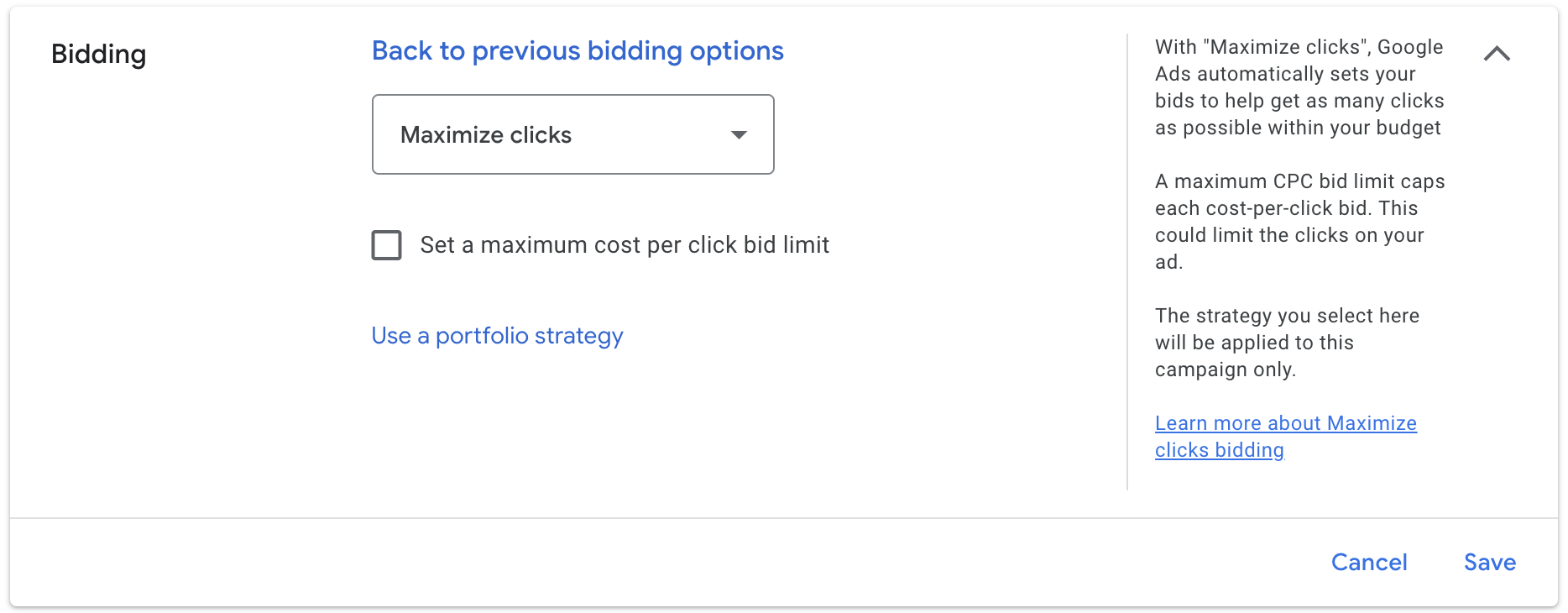
- Best Use Cases:
- Brand Awareness: When your primary aim is to increase visibility and drive traffic, rather than immediate conversions.11
- Initial Data Gathering: For new accounts or campaigns with limited search volume keywords, Maximize Clicks can help quickly accumulate traffic data and build audience lists, even before conversion tracking is fully mature.3 This “data harvesting” can inform later, more sophisticated bidding.
- Strong Conversion Funnel: If you already have a highly effective website and conversion process, driving more volume to it can be beneficial.15
- Top-of-Funnel Campaigns: Excellent for introducing your brand or content to a wider audience.11
Crucial Tip: ALWAYS Set a Maximum CPC (Cost-Per-Click) Bid Limit. This is paramount. Without a cap, Google’s algorithm, in its quest to maximize clicks, might bid very aggressively and spend your budget on excessively expensive clicks.3 A Max CPC limit gives you essential cost control and prevents your budget from evaporating on clicks that may not offer proportional value.
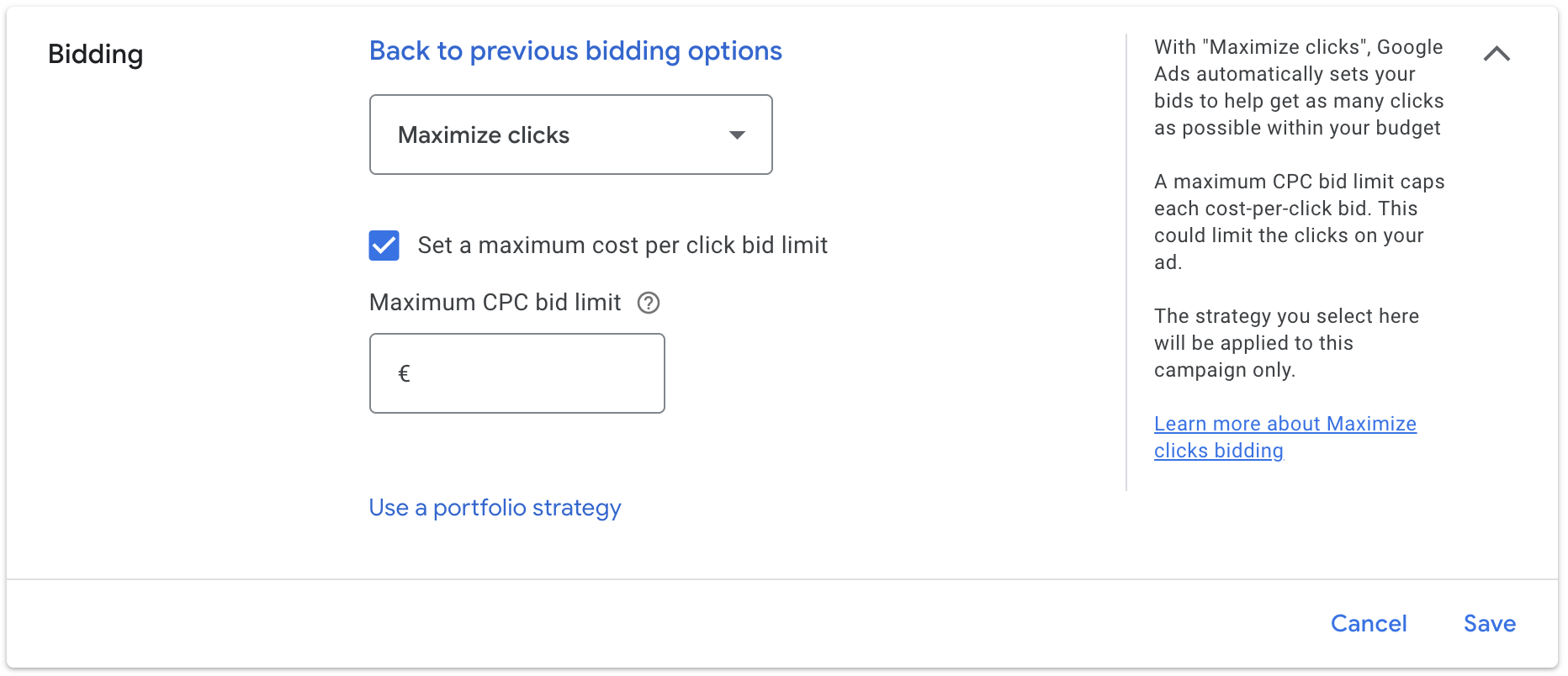
Considerations: This strategy prioritizes the quantity of clicks, not necessarily their quality or likelihood to convert.3 You’ll need to monitor your traffic quality and campaign performance closely to ensure it aligns with your broader goals. If you don’t set a Max CPC, you risk chasing “vanity metrics” – high click numbers that come at too high a cost, eroding any potential ROI.
Boosting Conversions: Smart Bidding in Action
When your goal shifts from just traffic to tangible actions – like leads, sales, or sign-ups – you’ll turn to conversion-focused Smart Bidding strategies.
Maximize Conversions
- Objective: To get the most conversions possible within your daily budget.1
- Mechanism: This is a fully automated Smart Bidding strategy. Google’s AI dynamically sets bids in real-time with the aim of maximizing the number of conversions your campaign can achieve, typically by trying to spend your full daily budget.5 It focuses on generating the highest volume of conversions, even if the cost for each individual conversion varies.17

- Optional Target CPA: A significant enhancement is the ability to add an optional Target CPA (Cost Per Acquisition) to this strategy.1 When you set a Target CPA, you instruct Smart Bidding to try and achieve as many conversions as possible at or near that average cost per acquisition. This transforms the strategy from a pure volume play to a more controlled volume approach, offering a balance between quantity and efficiency.
- Ideal Scenarios:
- Volume-Focused Goals: When your primary objective is to increase the sheer number of leads, sales, or sign-ups and you’re initially less concerned about a strict cost per conversion.17
- Sufficient Budget: If you have a campaign budget that you’re prepared to spend fully to drive as many conversions as possible.3
- “Smart Bidding Enabler”: For accounts that have some conversion data but perhaps not enough for highly specific Target CPA or Target ROAS strategies, Maximize Conversions can be an excellent intermediate step. It allows Google’s AI to learn more broadly “who converts” 7 before you apply stricter cost or return constraints. Many experts recommend using it after gathering an initial 30-50 conversions before progressing to tCPA or tROAS.7
- Considerations:
- Accurate Conversion Tracking is Essential: This strategy is entirely dependent on reliable conversion data.5
- Budget Management: Maximize Conversions will aim to spend your entire daily budget. It’s advisable for each campaign using this strategy to have its own dedicated budget to prevent it from consuming a shared budget unexpectedly.5
- Cost Fluctuation: Without a Target CPA set, the cost per conversion can vary and may sometimes be higher than desired as the algorithm prioritizes volume.17
Target CPA (Cost Per Acquisition)
- Objective: To get as many conversions as possible at or below a specific average cost per acquisition (CPA) that you define.1
- Mechanism: This is a Smart Bidding strategy where Google’s AI automatically sets bids with the goal of achieving your target CPA. While some individual conversions might cost more and others less, the strategy aims to average out at the CPA you’ve set over time.3
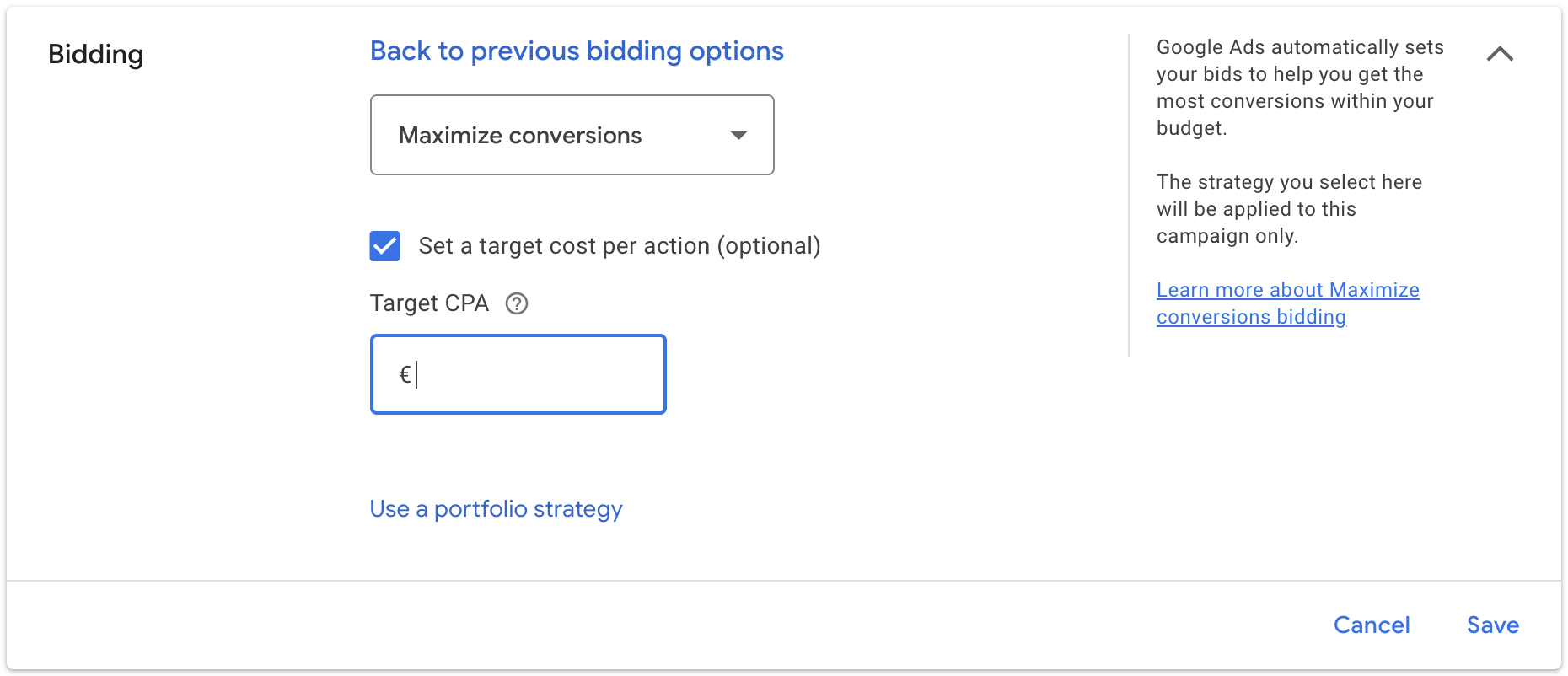
- Setting Achievable Targets: This is critical for success. Your Target CPA should be realistic and based on your historical campaign performance.3 Setting a Target CPA that is too low can severely limit your campaign’s volume and reach, as the algorithm will struggle to find conversions at an unachievable cost.5 A common approach is to look at your average cost per conversion over the last 30 days and set your initial Target CPA around that figure, perhaps slightly higher if you want to prioritize volume, or slightly lower if efficiency is key.7
- When it Shines:
- Lead Generation: Ideal for campaigns where you have a clear understanding of what a lead is worth to your business and you need to acquire those leads at a specific cost.17
- Profitability Control: When you know your allowable acquisition cost to maintain profitability, Target CPA acts as a direct lever to manage this.3
- Sufficient Conversion History: This strategy performs best when it has enough historical conversion data to learn from – typically recommended to have at least 30-50 conversions in the past 30 days.5
- Considerations:
- Accurate Conversion Tracking is Non-Negotiable: The AI needs this data to function.5
- Data Volume: If your campaign generates very few conversions, Target CPA may struggle to optimize effectively.11
- Availability: Target CPA can be used as a standard strategy for a single campaign or as a portfolio strategy across multiple campaigns.19 The challenge with Target CPA often lies in finding that “sweet spot” for your target. It’s a balancing act: too high might mean overpaying, while too low chokes volume. This necessitates ongoingRisk of Higher CPCs: With the removal of the bid adjustment cap, your actual CPCs can become much higher than your manual bid if Google aggressively pursues a conversion, potentially impacting profitability if not monitored closely.5
- Not Target-Focused: While it aims to increase conversion likelihood, ECPC doesn’t optimize towards a specific Target CPA.5 monitoring and iterative adjustments to your target, reinforcing that even “automated” strategies require active, strategic oversight.
Maximizing Revenue: Value-Focused Smart Bidding Strategies
For businesses, especially e-commerce, where not all conversions are created equal, value-focused strategies are paramount. These instruct Google’s AI to prioritize conversions that bring more monetary value.
Maximize Conversion Value
- Objective: To set bids in a way that maximizes the total monetary value of conversions (e.g., sales revenue) your campaign generates within its budget, rather than just focusing on the number of conversions.1
- Mechanism: This is a Smart Bidding strategy where Google’s AI analyzes various signals to predict the potential revenue or value each click and subsequent conversion might bring. It then adjusts bids to prioritize clicks that are likely to lead to higher-value transactions.5
- Optional Target ROAS: Similar to Maximize Conversions having an optional Target CPA, Maximize Conversion Value allows you to set an optional Target ROAS (Return On Ad Spend). This tells the AI to aim for the highest possible conversion value while also trying to achieve your specified ROAS.1
- Necessity of Value Tracking: This strategy is critically dependent on you accurately tracking different values for different conversion actions and passing this information back to Google Ads.5 If all your conversions are assigned the same value (or no value), this strategy will essentially function like Maximize Conversions. For example, a $1000 sale should be valued higher than a $5 newsletter signup for this strategy to work as intended.5

- Prime Use Cases:
- E-commerce Businesses: Especially those with a diverse product catalog where items have different price points and profit margins.17
- Prioritizing High-Value Outcomes: When generating more overall revenue is more important than just increasing the number of individual sales or leads.17
- Variable Conversion Values: If the monetary value of your conversions differs significantly (e.g., different service packages, lead quality tiers that correlate with potential deal size).17
- Sales-Driven Organizations: For businesses focused on acquiring leads or customers that have the highest potential lifetime value or immediate revenue impact.13
- Considerations: If you do not have conversion value tracking set up, or if all your conversions have the same value, this strategy will not be able to optimize effectively for value.5 This strategy, when correctly implemented with robust value tracking, aligns your Google Ads bidding most directly with actual business profitability and revenue growth. It moves the optimization focus beyond simple volume metrics to what truly impacts your bottom line. However, the operational challenge lies in accurately assigning and consistently tracking these conversion values, which can be complex for businesses with long sales cycles, offline conversion components, or nuanced customer lifetime value calculations.
Target ROAS (Return On Ad Spend)
- Objective: To maximize your conversion value while aiming to achieve a specific target return on ad spend (ROAS) that you set.1
- Mechanism: This is a Smart Bidding strategy where Google’s AI automatically sets bids to help you get as much conversion value as possible at the ROAS target you define.3 The system predicts future conversion values based on your historical performance data and various auction-time signals.5
- Calculating & Setting Targets: ROAS is calculated as: (Total Conversion Value (e.g., Revenue) / Total Ad Spend) x 100%.3 For example, if you want $5 in revenue for every $1 you spend on ads, your Target ROAS would be 500%. It is crucial to set a realistic ROAS target based on your historical data.5 Google Ads might even suggest a target based on your past performance.17 Setting an overly ambitious ROAS target can significantly limit your campaign’s reach and volume, as the AI will avoid auctions it deems unlikely to meet that high bar.11 A practical approach is to analyze your Conv. Value / Cost from the last 30 days and set your initial target around that, adjusting it 10-15% lower if you want more volume or 10-15% higher if you prioritize efficiency.7
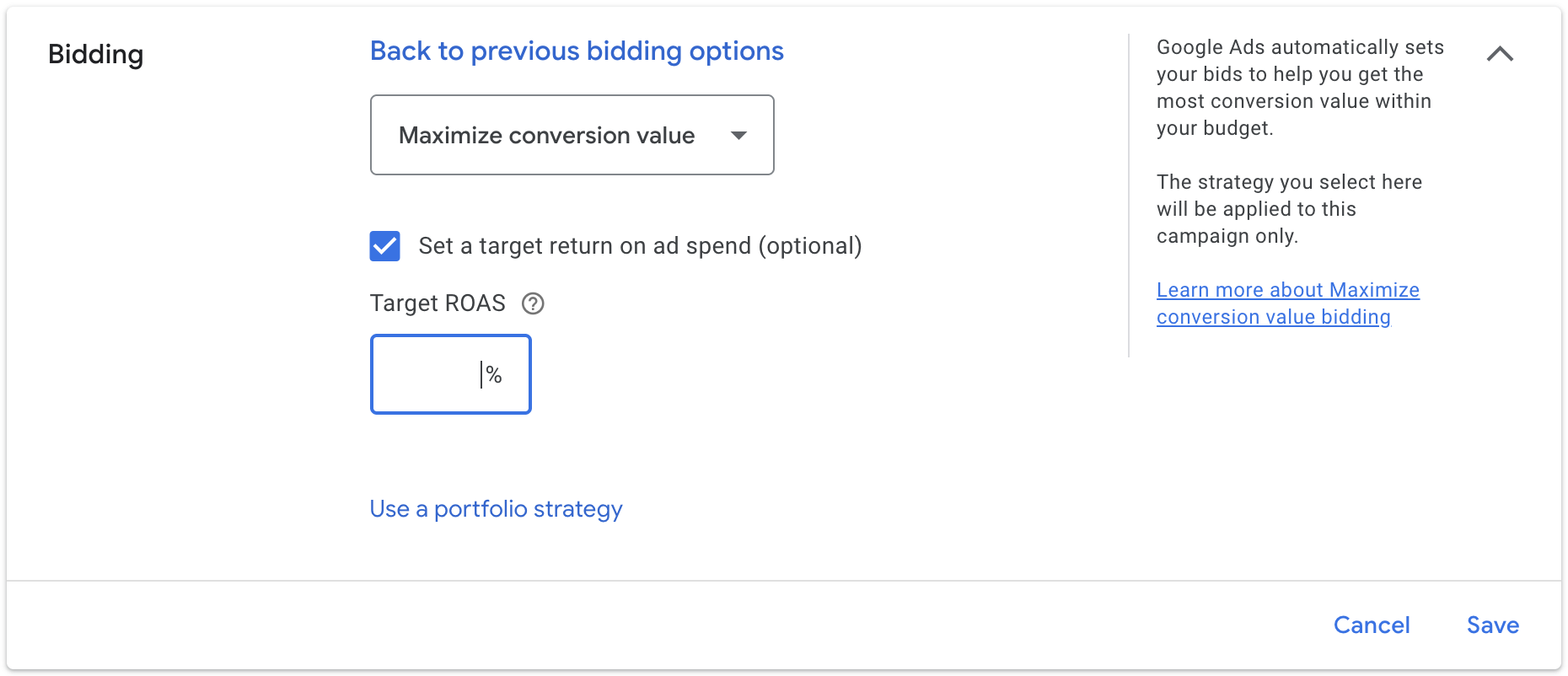
- When it’s Most Powerful:
- E-commerce Champions: This is often the go-to strategy for e-commerce businesses that have clear revenue goals and can accurately track the value of each sale.3 It directly links ad spend to revenue at a desired efficiency.
- Sufficient, Value-Tracked Data: Target ROAS is one of the most “data-hungry” strategies. It needs a good volume of historical conversions, each with reliable monetary values assigned. Minimum conversion thresholds often apply.4
- Considerations:
- Accurate Conversion Tracking with Values is Mandatory: Without this, the strategy cannot function.5
- Data Volume and Quality: Insufficient or inconsistent conversion value data can lead to poor performance or the algorithm struggling to optimize.5
- Strategy Evolution: It’s worth noting that Google has been evolving how these strategies are presented. In some instances, Target ROAS is now an optional setting within the Maximize Conversion Value strategy, rather than a completely standalone choice.4 However, it’s still widely referred to and functions as a distinct strategic approach.8 For e-commerce businesses, Target ROAS is often considered the ultimate efficiency tool, ensuring that ad spend translates into profitable revenue. However, its reliance on substantial and accurate conversion value data means it has higher prerequisites than many other bidding strategies.
Enhancing Visibility: Impression-Focused Strategies
Sometimes, your primary goal isn’t immediate clicks or conversions, but ensuring your brand is seen, especially in competitive markets or for crucial brand terms.
Target Impression Share
- Objective: To aim for your ads to show up for a certain percentage of the total eligible impressions, at specific locations on the Google search results page.1
- Mechanism: Google’s AI automatically sets your bids to try and achieve your desired impression share goal in the page location you’ve chosen.1
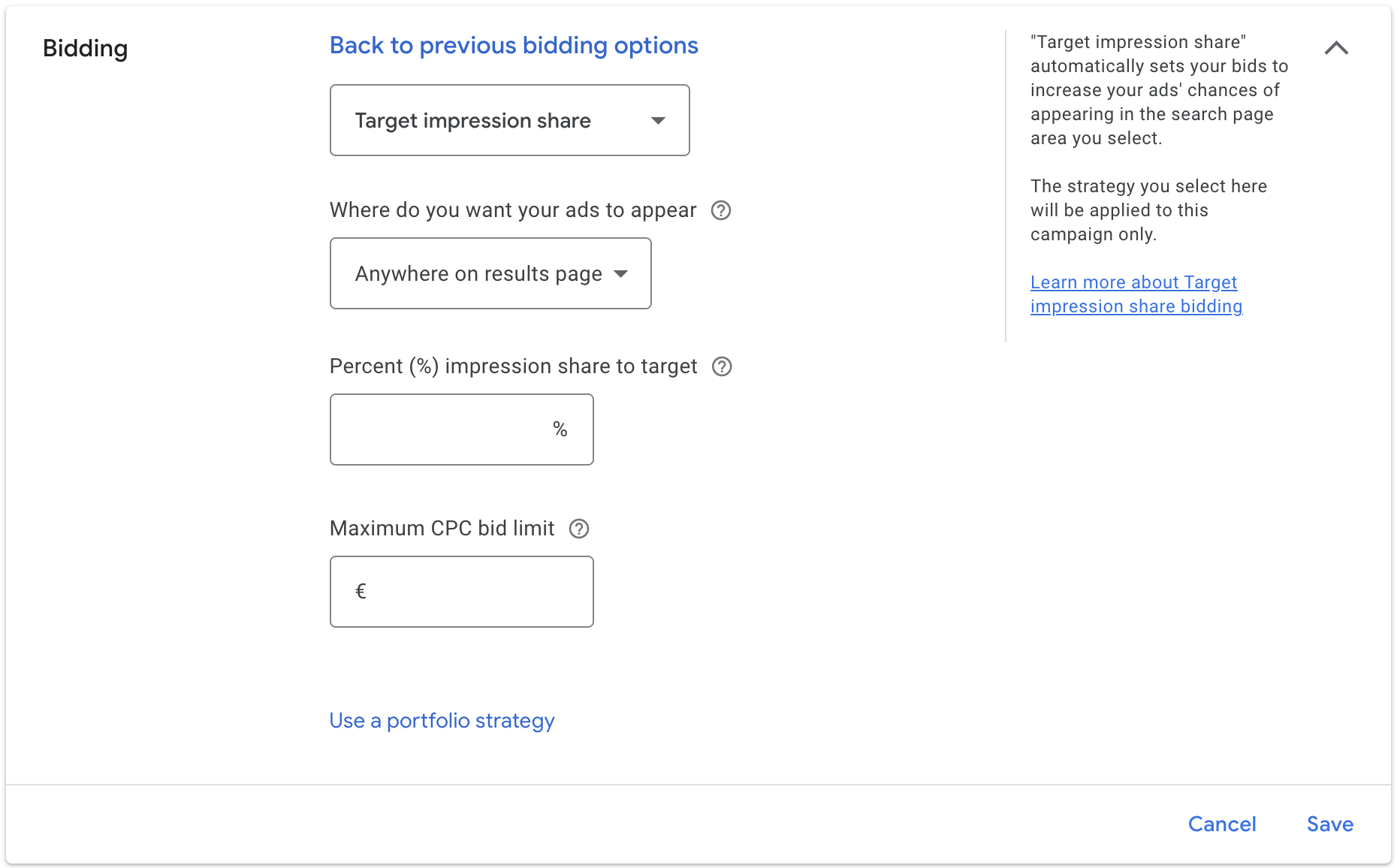
- Placement Choices: You can target:
- Absolute Top of Page: The very first ad position.3
- Top of Page: Any ad position above the organic search results.3
- Anywhere on the Page: Any ad position on the first page of search results.3
- Best For:
- Brand Awareness: When maximizing visibility and ensuring your brand is seen by as many relevant searchers as possible is the key objective.3
- Brand Term Protection: Crucial for defending your brand keywords, ensuring you appear prominently when users search directly for your business and making it more expensive for competitors to bid on your brand name.3
- Competitive Niches: Where maintaining a strong presence on the search engine results page (SERP) is strategically important.
- Importance of Max CPC Limit: It is highly recommended to set a maximum CPC bid limit when using Target Impression Share. Without this control, the strategy can significantly increase your bids to achieve the desired impression share, potentially leading to very expensive clicks and budget depletion.3
- Considerations: This strategy focuses purely on visibility (impressions), not necessarily on clicks or conversions.13 It can become expensive if a Max CPC limit isn’t carefully managed.4 Achieving a 100% impression share is rarely possible due to various auction dynamics.5 Target Impression Share serves as both a defensive tool (protecting brand terms) and an offensive one (dominating visibility for strategic non-brand terms). However, it’s vital to balance this visibility goal with profitability by using a Max CPC limit and evaluating if the achieved exposure translates into tangible business benefits.
Other Notable Bidding Options (Brief Overview)
While many businesses using Google Ads focus on Search campaigns for direct response, it’s important to be aware of bidding strategies tailored for Display Network and Video campaigns, especially for broader awareness goals.
- CPM (Cost Per Mille / Cost Per Thousand Impressions): With CPM bidding, you pay based on the number of times your ad is shown (impressions), specifically per 1,000 impressions. This is primarily used for campaigns on the Google Display Network and YouTube Ads when the main goal is to maximize brand exposure.3 It’s important to note that you are charged for impressions even if the user skips your video ad.4
- vCPM (Viewable Cost Per Thousand Impressions): An evolution of CPM, with vCPM you pay per 1,000 viewable impressions. An ad is typically counted as viewable if at least 50% of it is on screen for at least one second (for display ads) or two seconds (for video ads).3 This strategy is available for Display Network campaigns and offers a better guarantee that your ad was actually seen by users.3 It’s good for brand awareness but not ideal for driving direct conversions.3
- CPV (Cost Per View): This bidding strategy is specific to YouTube video campaigns. You pay when someone watches your video ad for at least 30 seconds (or the entire video if it’s shorter than 30 seconds) or when they interact with your video ad (e.g., click on a call-to-action overlay).4 CPV is suitable for increasing video views, engagement, or building product and brand consideration.6 While often inexpensive per view, it’s generally not expected to drive a high volume of direct conversions.4
These impression and view-based strategies are vital components of a full-funnel marketing approach. While direct-response strategies target users ready to convert, these top-of-funnel strategies help build brand awareness and consideration, creating a larger pool of potential customers who may convert later through other campaigns or channels. The distinction of “viewability” with vCPM also reflects an important industry shift towards ensuring that ad spend on visual media translates into actual exposure, not just served impressions that may never have been seen.
Streamlining Management: Standard vs. Portfolio Bidding Strategies
As you manage multiple campaigns, Google Ads offers ways to streamline your bidding approach through standard and portfolio strategies. Understanding the difference can significantly impact your efficiency and performance.
- Standard Bidding Strategies: These are applied at the individual campaign level. You set and manage the bidding strategy directly within that specific campaign’s settings.19 Each campaign operates with its own isolated bidding logic.
- Portfolio Bidding Strategies: These are automated, goal-driven bid strategies that you can create and then share across multiple campaigns, ad groups and even keywords.15 Portfolio strategies are housed and managed in your account’s “Shared library”.21
The core distinction is that portfolio strategies allow Google’s AI to optimize bids collectively across all grouped campaigns to achieve a shared performance goal.15 Instead of each campaign learning in isolation, they contribute to and benefit from a larger pool of data.
Advantages of Portfolio Bidding Strategies:
- Centralized Management and Tracking: Simplifies the management and performance monitoring for a group of campaigns that share similar objectives. You can see how the overall strategy is performing in one place.15
- Shared Learning & Enhanced AI Performance: This is a key benefit. By pooling data from multiple campaigns, Google’s AI has a larger and more diverse dataset to learn from. This can lead to faster learning periods, more robust optimization and potentially better performance, especially if individual campaigns within the portfolio have limited conversion data on their own.15 This helps advertisers get a “better understanding of their bidding efforts”.15
- Improved Efficiency and Time Savings: Automating bids across several campaigns using a single portfolio strategy significantly reduces the time spent on manual adjustments for each one.15
- Potentially Better Results: The aggregated data and cross-campaign learning can lead to more optimized bids, potentially resulting in more conversions or clicks, depending on your chosen strategy and goal.15
When Should You Leverage Portfolio Strategies?
- When you have several campaigns that share the exact same performance goal (e.g., all campaigns are targeting the same CPA, or the same ROAS).15
- If individual campaigns lack sufficient conversion volume to effectively use Smart Bidding on their own, but when combined, they meet the data thresholds. The portfolio strategy can then leverage this combined data.
- To ensure a consistent bidding approach and optimization logic across a set of related campaigns.
Supported Strategies for Portfolios:
The powerful Smart Bidding strategies like Maximize Conversions, Maximize Conversion Value, Target ROAS and Target CPA, as well as automated strategies like Maximize Clicks and Target Impression Share, can all be used within a portfolio structure.21
The ability of portfolio strategies to aggregate data for AI learning is perhaps their most significant advantage. Smart Bidding thrives on data; the more relevant data it has, the better its predictions and bid adjustments become. Grouping campaigns strategically is crucial, however. For portfolio strategies to be effective, the campaigns within them should have genuinely similar strategic objectives and target metrics. For instance, grouping campaigns with vastly different Target CPAs or targeting entirely different stages of the customer journey into a single portfolio could lead to suboptimal results, as the AI might struggle to optimize for an “average” that doesn’t truly fit any individual campaign’s needs.15
Take Control of Your Bids, Accelerate Your Growth
The future of Google Ads bidding is undoubtedly AI-assisted, but it remains critically human-guided. While algorithms handle more of the granular, real-time decision-making, your strategic insight in setting overarching goals, ensuring data quality, interpreting complex performance scenarios and making high-level adjustments is irreplaceable.
Ready to take control of your Google Ads bids and accelerate your growth? The expert team at Perfometrics is here to help you navigate the complexities of Google Ads bidding, tailor strategies to your unique business needs and unlock superior performance.
Contact us today for an expert consultation and let’s build your success story together.
References
- What Is Keyword Bidding? A Beginner’s Step-by-Step Guide, accessed on June 3, 2025, https://www.semrush.com/blog/keyword-bidding/
- Paid Search Bidding Strategies – Neil Patel, accessed on June 3, 2025, https://neilpatel.com/blog/ppc-bidding-strategies/
- Choosing the Right Google Ads Bid Strategy [Guide] – Brafton, accessed on June 3, 2025, https://www.brafton.de/blog/ppc-werbung/google-ads-bid-strategy/
- 11 Best Google Ads Bidding Strategies + Expert Tips [2025] – Mayple, accessed on June 3, 2025, https://www.mayple.com/resources/googleadvertising/bidding-strategies-google-ads
- The Pros & Cons of Every Automated Bidding Strategy in Google, accessed on June 3, 2025, https://www.wordstream.com/blog/ws/2018/12/19/google-ads-automated-bidding
- Determine a bid strategy based on your goals – Google Ads Help, accessed on June 3, 2025, https://support.google.com/google-ads/answer/2472725?hl=en
- When to Use Each Google Ads Bid Strategy : r/DigitalMarketing – Reddit, accessed on June 3, 2025, https://www.reddit.com/r/DigitalMarketing/comments/1k634a7/when_to_use_each_google_ads_bid_strategy/
- About automated bidding – Google Ads Help, accessed on June 3, 2025, https://support.google.com/google-ads/answer/2979071?hl=en
- About Smart Bidding – Google Ads Help, accessed on June 3, 2025, https://support.google.com/google-ads/answer/7065882?hl=en
- Automated bid strategy: Definition – Google Ads Help, accessed on June 3, 2025, https://support.google.com/google-ads/answer/6325042?hl=en
- Your guide to Google Ads Smart Bidding – Search Engine Land, accessed on June 3, 2025, https://searchengineland.com/your-guide-to-google-ads-smart-bidding-453765
- AI-powered Smart Bidding & Bid Optimizations – Google Ads, accessed on June 3, 2025, https://business.google.com/us/ad-tools/bidding/
- Automated Bidding Strategies to Maximize Your PPC Campaigns, accessed on June 3, 2025, https://neilpatel.com/blog/automated-bidding/
- Choose your Smart Bidding strategy for display campaigns – Google Ads Help, accessed on June 3, 2025, https://support.google.com/google-ads/answer/10276703?hl=en-GB
- Portfolio Bid Strategy: What is it, Why you need it, How to use it? – TNA Suite, accessed on June 3, 2025, https://www.tnasuite.com/blog/portfolio-bid-strategy-what-is-it-why-you-need-it-how-to-use-it/
- Finding success with Smart Bidding – Google Ads Help, accessed on June 3, 2025, https://support.google.com/google-ads/answer/6167140?hl=en
- Google Ads Smart Bidding: Breaking Down 5 Top Strategies – WordStream, accessed on June 3, 2025, https://www.wordstream.com/blog/google-ads-smart-bidding
- Pick the right bid strategy – Google Ads Help, accessed on June 3, 2025, https://support.google.com/google-ads/answer/6167148?hl=en
- Bidding Strategy Types | Google Ads API, accessed on June 3, 2025, https://developers.google.com/google-ads/api/docs/campaigns/bidding/strategy-types
- The Best Google Ads Bidding Strategy | Complete Guide – Promodo, accessed on June 3, 2025, https://www.promodo.com/blog/bidding-strategy-in-google-ads
- Portfolio bid strategy: Definition – Google Ads Help, accessed on June 3, 2025, https://support.google.com/google-ads/answer/6263072?hl=en
- Bid Strategy Breakdown: Finding the Perfect Fit for Your Ads – Linear, accessed on June 3, 2025, https://lineardesign.com/blog/bid-strategy-google-ads/
- How to Set Up Portfolio Bid Strategies in Google Ads – TripleDart, accessed on June 3, 2025, https://www.tripledart.com/marketing-tutorials/how-to-set-up-portfolio-bid-strategies-in-google-ads
- Portfolio and Standard Bidding Strategies | Google Ads API, accessed on June 3, 2025, https://developers.google.com/google-ads/api/docs/campaigns/bidding/assign-strategies
- Google Ads Portfolio Bid Strategy – YouTube, accessed on June 3, 2025, https://www.youtube.com/watch?v=ehKKPEssRmI
- A Comprehensive Guide to Bidding Strategies in Google Ads – Techiegigs, accessed on June 3, 2025, https://techiegigs.com/a-guide-for-bidding-strategies-in-google-ads/
- Effective Bid Strategies for Google Ads – Loves Data, accessed on June 3, 2025, https://www.lovesdata.com/blog/effective-bid-strategies-for-google-ads/
- How to Set a Google Ads Budget for Optimal Results – Tactica, accessed on June 3, 2025, https://seotactica.com/ppc/google-ads-budget/
- How To Set Up Google Ads: A Checklist, accessed on June 3, 2025, https://business.google.com/us/resources/articles/how-to-setup-google-ads-a-checklist/
- Google Ads Bid Strategy : r/googleads – Reddit, accessed on June 3, 2025, https://www.reddit.com/r/googleads/comments/17knrre/google_ads_bid_strategy/
- Introducing Google Ads recommendations on HubSpot – YouTube, accessed on June 3, 2025, https://www.youtube.com/watch?v=8O6d0S2xY_Q
- Google Ads Bidding Strategies Explained: When to Use & When to Switch – YouTube, accessed on June 3, 2025, https://www.youtube.com/watch?v=hdX0ZTTH3w0


